Staveley, Westmorland: Difference between revisions
No edit summary |
|||
| Line 15: | Line 15: | ||
|constituency=Westmorland and Lonsdale | |constituency=Westmorland and Lonsdale | ||
}} | }} | ||
'''Staveley''', otherwise known as '''Staveley-in-Westmorland''', is a village in [[Westmorland]], in the heart of the [[Lake District]]. It may be found four miles north-west of [[Kendal]] where the [[River Kent]] is joined by its tributary the [[River Gowan, Westmorland|Gowan]]. | '''Staveley''', otherwise known as '''Staveley-in-Westmorland''', is a village in [[Westmorland]], in the heart of the [[Lake District]]. It may be found four miles north-west of [[Kendal]] where the [[River Kent]] is joined by its tributary the [[River Gowan, Westmorland|Gowan]]. The population of the village and its parish at the 2011 Census was recorded at 1,147. | ||
==Name== | ==Name== | ||
| Line 46: | Line 46: | ||
===Woods=== | ===Woods=== | ||
[[File:Craggy Plantation - geograph.org.uk - 1325821.jpg|right|thumb|200px|Craggy Plantation]] | [[File:Craggy Plantation - geograph.org.uk - 1325821.jpg|right|thumb|200px|Craggy Plantation]] | ||
[[File:St. Margaret's Tower.jpg|right|thumb|200px|St | [[File:St. Margaret's Tower.jpg|right|thumb|200px|St Margaret's Tower, the only remains of a former mediæval church]] | ||
Woods in the area include: | Woods in the area include: | ||
| Line 60: | Line 60: | ||
[[File:St. James's Church, Staveley.jpg|left|thumb|200px|St James's Church]] | [[File:St. James's Church, Staveley.jpg|left|thumb|200px|St James's Church]] | ||
[[File:Staveley angel playing harp.JPG|left|thumb|100px|Stained glass window at St | [[File:Staveley angel playing harp.JPG|left|thumb|100px|Stained glass window at St James's by Sir Edward Burne-Jones]] | ||
At the weir by Wilf's Café in Staveley Mill Yard, visitors can see water being drawn from the River Kent, which originally powered a waterwheel, replaced in 1902 with turbines. | At the weir by Wilf's Café in Staveley Mill Yard, visitors can see water being drawn from the River Kent, which originally powered a waterwheel, replaced in 1902 with turbines. | ||
Latest revision as of 20:04, 24 May 2017
| Staveley | |
| Westmorland | |
|---|---|
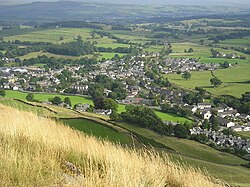 Staveley from Reston Scar | |
| Location | |
| Grid reference: | NY469981 |
| Location: | 54°22’30"N, 2°49’5"W |
| Data | |
| Population: | 1,147 (2011) |
| Post town: | KENDAL |
| Postcode: | LA8 |
| Dialling code: | 01539 |
| Local Government | |
| Council: | Westmorland & Furness |
| Parliamentary constituency: |
Westmorland and Lonsdale |
Staveley, otherwise known as Staveley-in-Westmorland, is a village in Westmorland, in the heart of the Lake District. It may be found four miles north-west of Kendal where the River Kent is joined by its tributary the Gowan. The population of the village and its parish at the 2011 Census was recorded at 1,147.
Name
The village derives its name from the woodland that once shrouded the fells and dales hereabouts and the consequent industry: felling and woodworking, which drew power from the two rivers that meet here. Staveley means literally the 'field of staves', from the Old English stafa leah, or the Middle English equivalent.
The village is named simply 'Staveley', but is also known as 'Staveley-in-Westmorland' and 'Staveley-in-Kendal' to distinguish it from Staveley-in-Cartmel, a small village close by across the county border in Lancashire.
Geography
The village is strategically placed at the junction of the rivers Kent and Gowan, at the mouth of the Kentmere Valley.
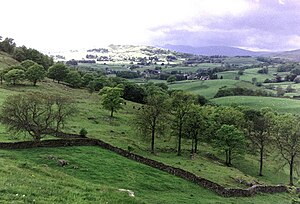
Three hills overlook the village: Reston Scar on the north side on which much of the village is built, Piked Howe to the north-east, known to the locals as Craggy Wood, and Lily Fell to the south in the direction of the village of Crook on the opposite side of the A591 bypass. Piked Howe and Reston Scar sit either side of the opening into the Kentmere Valley. Both mark the beginning of a larger horseshoe chain of hills known as the 'Kentmere Round'.
The nearest village to the west is Ings, a small settlement which now shares schools and parish minister with Staveley. To the south of the village is Crook, and to the north Kentmere which can only be accessed by road by way of Staveley village centre, meaning that the two villages have been forced into a close relationship with each other for many centuries. But the village which had the strongest links to Staveley in more recent years is arguably Burneside which is the next stop on the railway line to the east on the way to Kendal. National Cycle Route 6 and the Dales Way footpath run through Burneside and Staveley.
History
It has been suggested that the Romans built a road near Staveley to link the Roman forts at Kendal (Alauna) and Ambleside (Galava).[1] However, the existence of any Roman road in the immediate vicinity of Kendal is not confirmed.[2] On the other hand, the Roman road at High Street (a few miles north of Staveley) is well evidenced.
Weekly markets and a three-day annual fair were held from 1329 when the village was granted a market charter.
In the 18th century a turnpike road from Kendal to Ambleside was constructed through Staveley. In Dorothy Wordsworth's journal for 1802 there are references to an inn at Staveley (possibly the Eagle and Child).[3][4] She wrote: "I am always glad to see Stavel(e)y; it is a place I dearly love to think of"
Since the 1840s Staveley has had a railway station on the Windermere Branch Line from Windermere Village to Oxenholme. It is one of only a few locations in the Lake District National Park to have a station, but in the 19th century most tourists continued their journey to the railhead at Windermere. Staveley remained relatively unaffected by mass tourism until the 20th century.
Another 19th century project built through Staveley is the Thirlmere Aqueduct, commissioned in 1894. On its way to Manchester, the aqueduct passes under the River Kent at Staveley.[5] Although the Staveley section of the aqueduct was constructed underground (via "cut-and-cover" and tunnelling techniques), some of the infrastructure associated with it is visible.

Woods
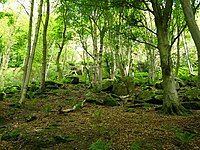

Woods in the area include:
- Beckmickle Ing (8.85 acres) which is managed by the Woodland Trust
- Craggy Plantation, which belongs to the Lake District National Park Authority and is mainly deciduous. This area was used in the 1990s for testing various measures to control the spread of North American grey squirrels into the native red squirrel habitats.
- Dorothy Farrer's Spring Wood (11.4 acres), which is managed by the local Wildlife Trust. There is a tradition of coppicing, which the trust continues in the interests of biodiversity. Birdlife includes the pied flycatcher.
- Mike's Wood (7.4 acres) native woodland planted in the 1990s by the organisation Friends of the Lake District.[6]
Mills
In the Middle Ages, the mills at Staveley produced woollen cloth. During the Industrial Revolution there was cotton production at Staveley, and there is an 18th-century mill building from this time. The cotton industry shifted to the towns of Lancashire though, and the Staveley mills were converted to work wood. By 1850 bobbin turning was the main industry in the valley.
While there is no longer any bobbin production, there are a carpentry businesses in the village.[7]
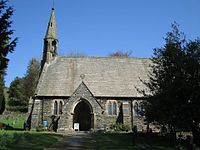
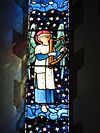
At the weir by Wilf's Café in Staveley Mill Yard, visitors can see water being drawn from the River Kent, which originally powered a waterwheel, replaced in 1902 with turbines.
Historic buildings
A conservation area protects much of the centre of Staveley.[8] There are proposals to extend the conservation area across the River Kent to include a garden designed by Thomas Mawson.
Staveley has a number of listed buildings, including its oldest building, a tower, all that remains of a mediæval church dedicated to St Margaret. The structure is maintained as a clock-tower: on it is a plaque commemorating the Staveley men of F Company, Second V B Border Regiment, who served in the South Africa Campaign of 1900–01 under Major John Thompson.
In 1338 the then Lord of the Manor, Sir William Thweng agreed to build a church. Before this the villagers had been expected to travel 7 miles to Kendal each Sunday for services. The church, completed in 1388, was replaced by a new parish church, built in 1864–65 to a design by J. S. Crowther. This Victorian church, dedicated to St James, is notable for the stained glass windows at the east end, which were designed by Sir Edward Burne-Jones and made by Morris and Co. They depict the Crucifixion and Ascension of Christ surrounded by angels and stars.[9] One of the angels was used for the Royal Mail's second class Christmas stamp in 2009.
Other places of worship

- Two former chapels, which were Wesleyan Methodist and Primitive Methodist before the Methodist Union in 1932 have been converted for residential use.
- A small Roman Catholic church sits disused on Station Road
Events
Every year in August residents put on an art exhibition for regional artists at the Roundhouse (a former gas holder which serves as a theatre).[10]
Outside links
| ("Wikimedia Commons" has material about Staveley, Westmorland) |
- Staveley Village Association
- Staveley with Ings Parish Council
- Staveley Village
- Staveley and District Historical Society
- Virtual Tours of Staveley
- The Operatic Society's fiftieth production (dead-link)
- Staveley CE School
- St James' CofE church
- Wilf's Cafe – formerly the Bobbin Life
- Staveley Natural Health Centre
- Staveley Carnival
References
- ↑ "Roman Routeplanner". Omnes Viae. http://omnesviae.org/. Retrieved 27 February 2013.
- ↑ Alavana
- ↑ Berry, John. "The Eagle and Child". http://www.sdhs.org.uk/wp-content/uploads/2011/08/24-Eagle.pdf. Retrieved 31 January 2014.
- ↑ The Eagle and Child Inn
- ↑ [1]
- ↑ Step through wonderful Staveley woodlands. Friends of the Lake District
- ↑ Prince Charles to visit South Lakeland – The Westmorland Gazette
- ↑ Staveley Conservation Area
- ↑ photographs of the William Morris & Co. east window, Stained Glass Photography website
- ↑ Staveley Roundhouse
